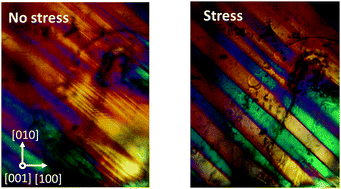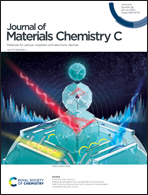Ferroelasticity, domain structures and phase symmetries in organic–inorganic hybrid perovskite methylammonium lead chloride†
Abstract
Hybrid organic–inorganic perovskites CH3NH3PbX3 (X = I, Cl and Br) have recently been developed as highly efficient materials for optoelectronic applications. However, the mechanisms of their extraordinary performance remain poorly understood. It has been suggested that ferroelectric domains may be responsible for photovoltaic behavior of hybrid perovskites employed in solar cells, but the very existence of ferroelectricity in these materials remains debatable. Furthermore, due to the presence of disordered organic group, the hybrid crystal structure is difficult to determine by conventional diffraction methods and controversial results have been reported. In this work CH3NH3PbCl3 crystals are investigated using polarized light microscopy in the temperature range from 80 to 600 K. It is found that symmetry of the phase appearing after the high-temperature cubic phase upon cooling is orthorhombic but not tetragonal, as believed before. It transforms into another orthorhombic phase at a lower temperature. In both orthorhombic phases twin domains are found and examined under mechanical stress and electric field. The crystal proved to be ferroelastic but not ferroelectric.



 Please wait while we load your content...
Please wait while we load your content...